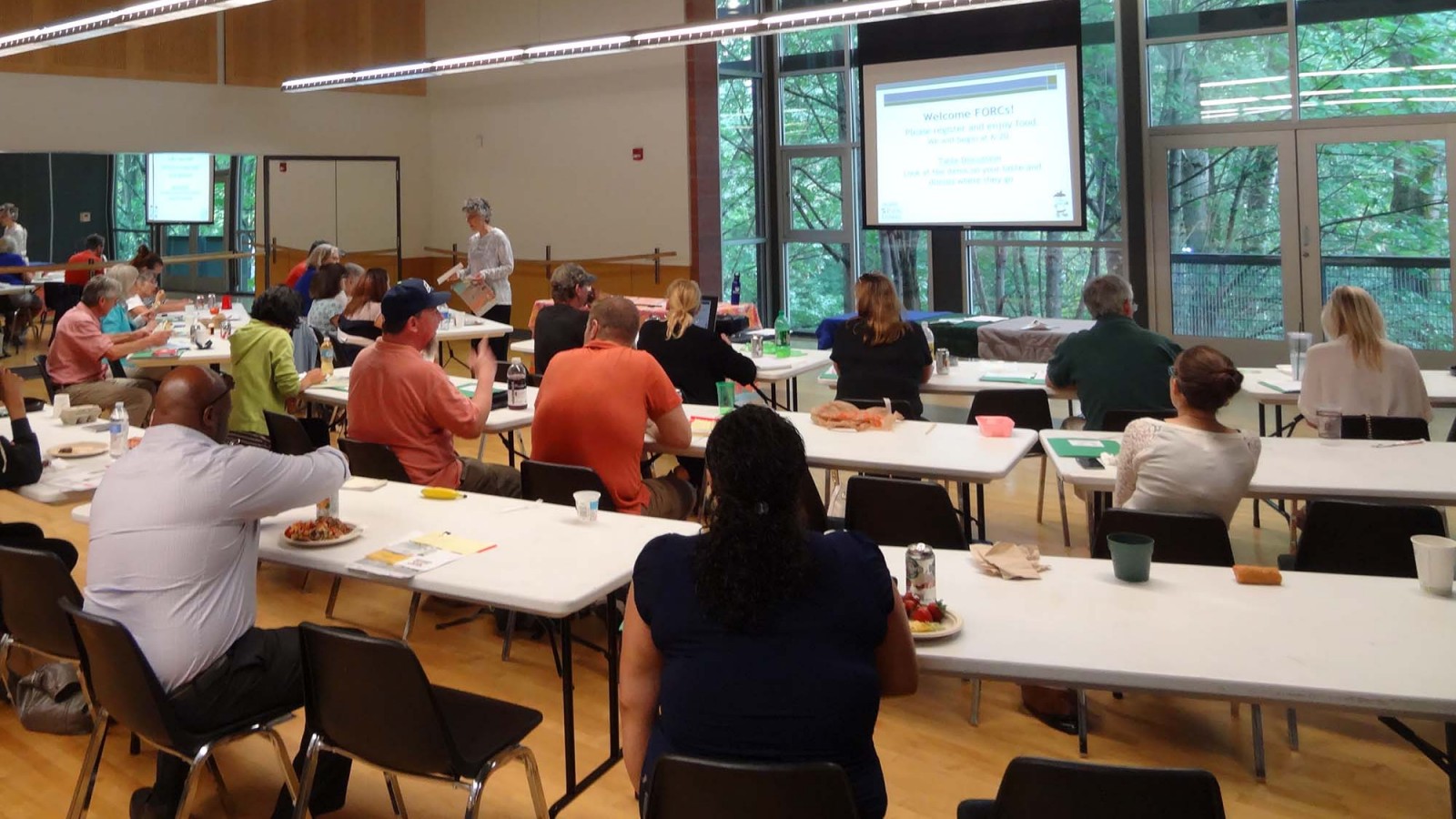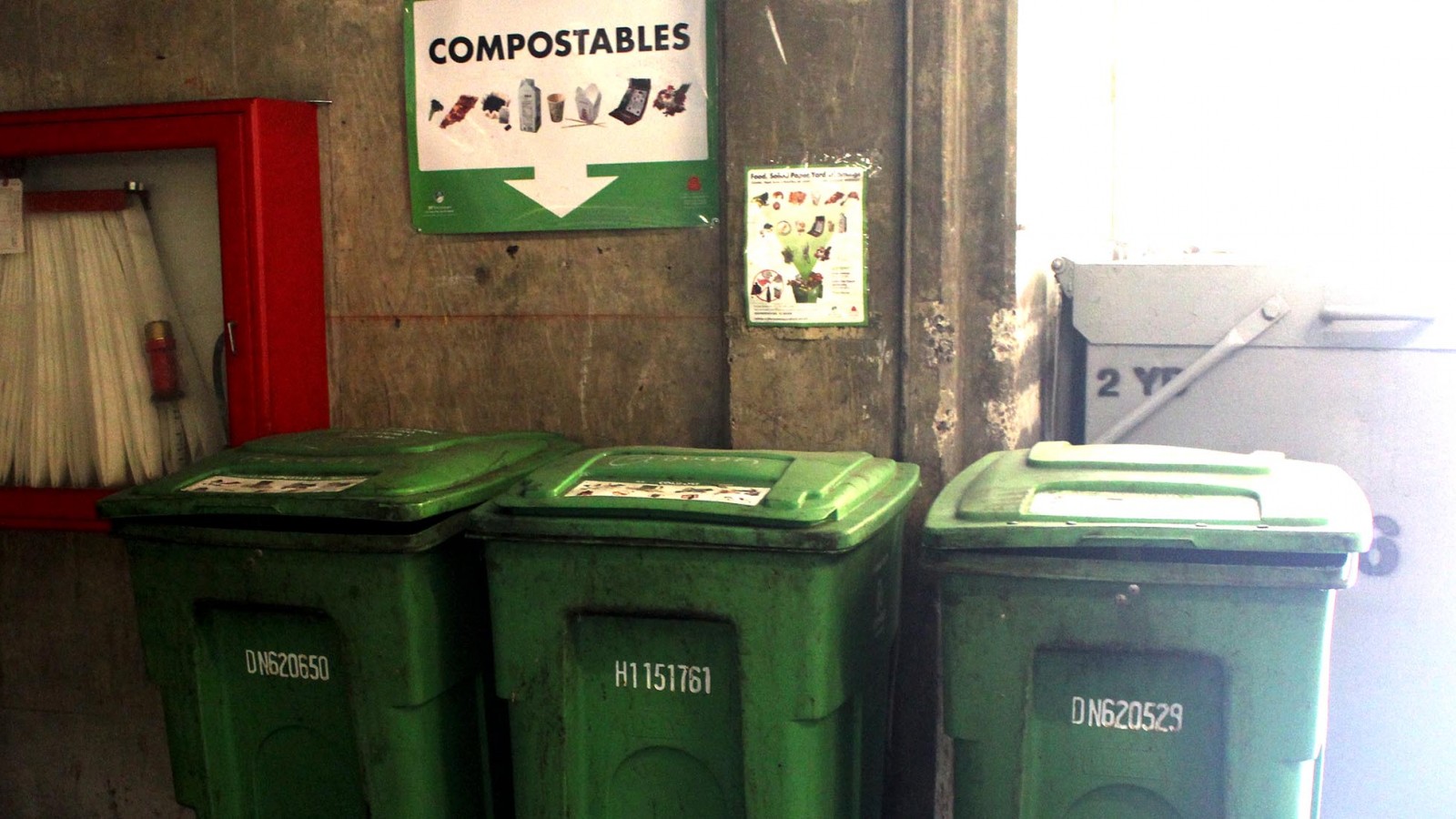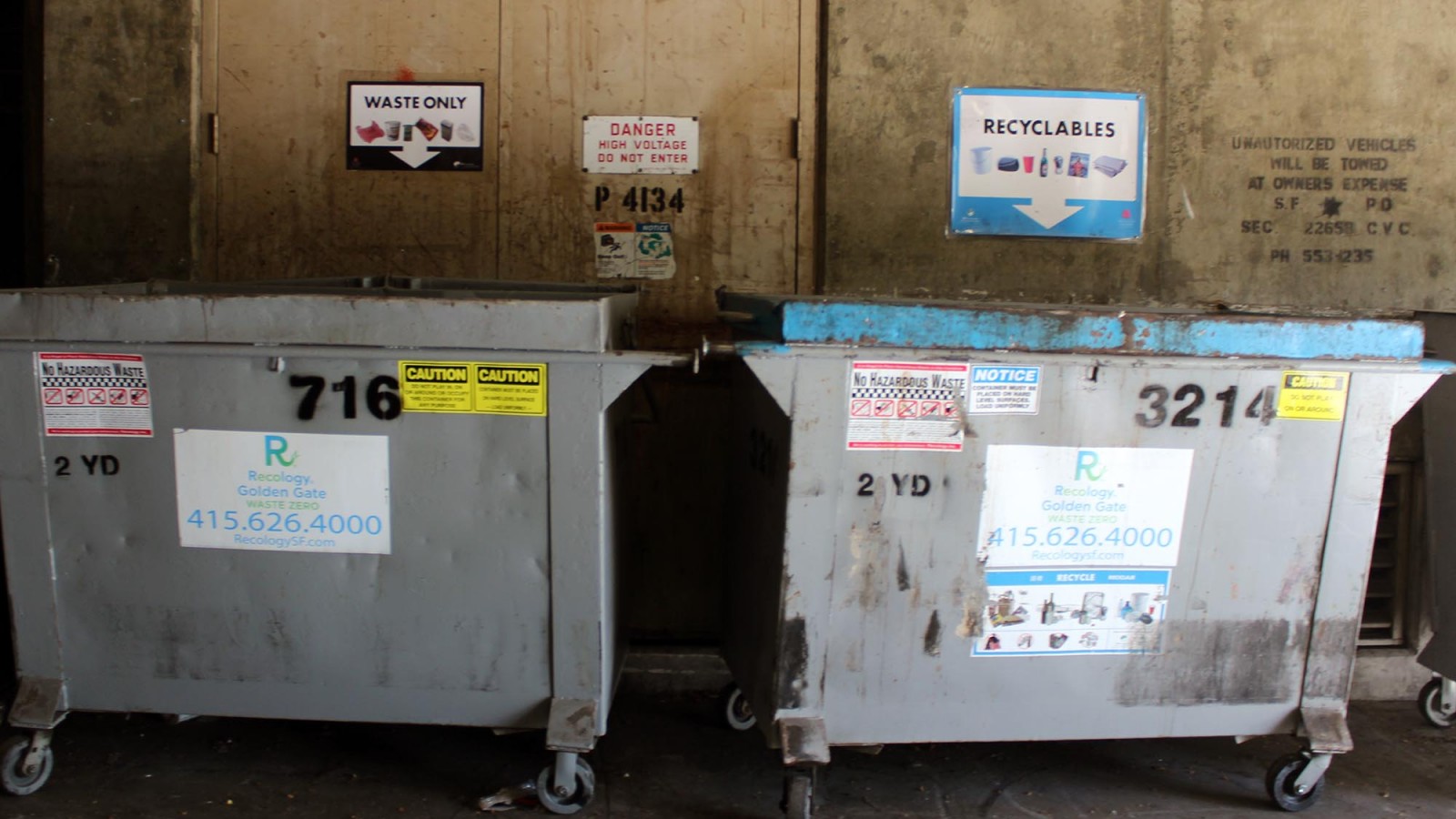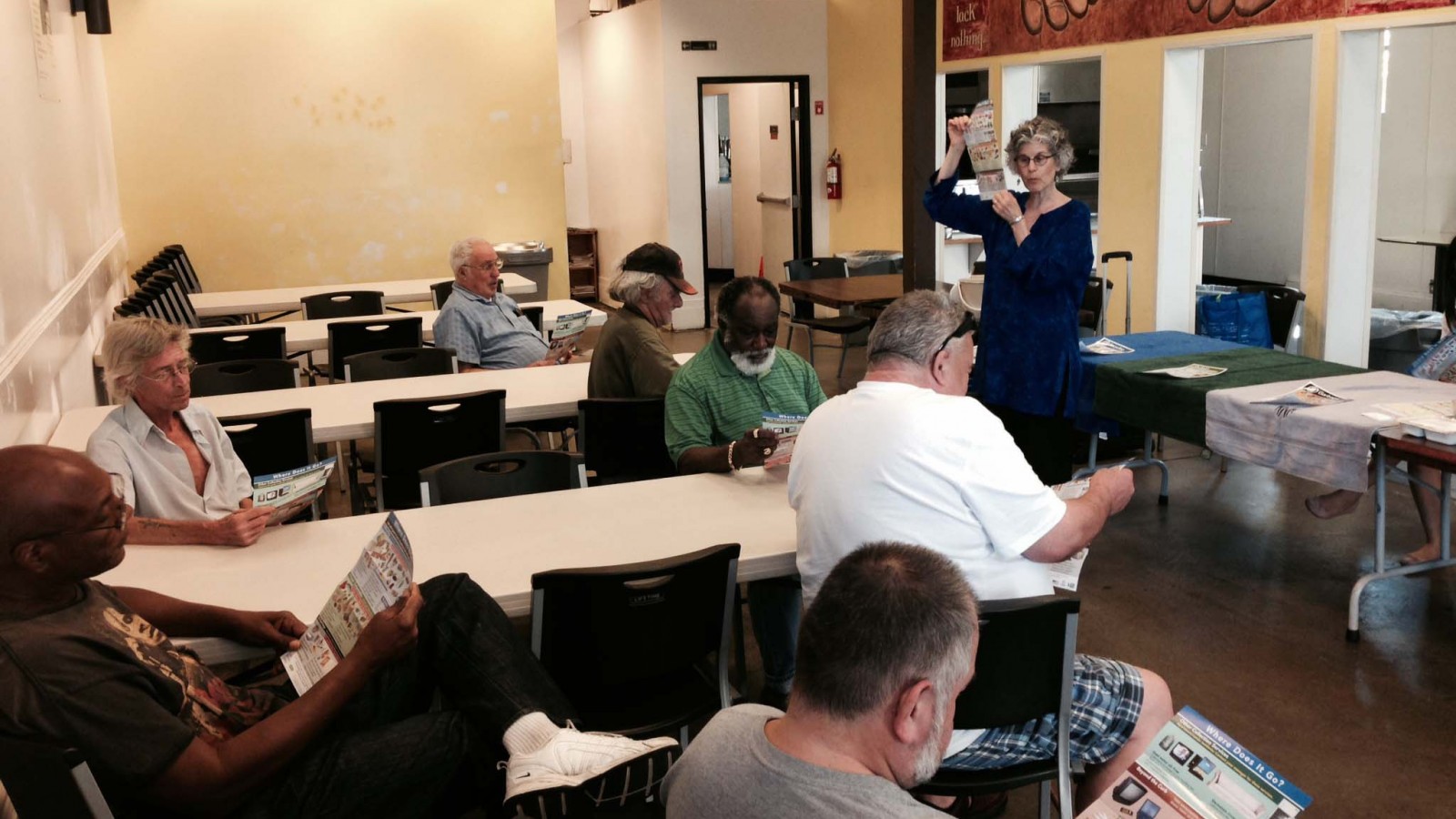Transcript:
CHAPTER 5: COMMITMENT FROM TENANTS
THE ORGANIC STREAM: As I said in the first episode, successful organics recycling is all about building relationships. Once you have established a relationship with the building manager or owner, the focus is going to be on getting the tenants on board and participating.
And this is not always easy.
Introducing an organics recycling program anywhere requires a commitment of time and resources into education, face-to-face engagement, tailoring your outreach strategies to specific demographics…and sustaining relationships.
In general: engagement strategies will consist of targeted outreach efforts well in advance of the program roll-out. Then, after roll-out, the focus is on increasing participation with continuous on-site education, gathering feedback, reworking flyers and messaging – and so on.
With multistory buildings, there are a few extra challenges you can face in terms of tenant engagement.
Firstly, the turnover of tenants – which can be quite high depending on the property – will mean you need to ensure that every new person moving into the building is educated and aware of the program. This is often taken on by the building managers.
As well as the transient nature of the populations, there is sometimes a lack of a community feeling in a multistory building – which can lead to lack of interest in attending building meetings, for example, or just a lack of interest in how well the building is performing. As I said many times in the first episode, every building is different and your outreach strategies will have to be tailored to meet the building’s unique challenges – which includes getting tenants invested in the program.
We won’t be delving too deep into the engagement and education strategies here, because we’re focusing heavily on this in our upcoming case-study episode. But it’s important to get an overview of kind of work it involves. And for this I want to take us back to New York.
Last episode, we heard from Jessica Schreiber of the DSNY about their voluntary organics recycling pilot program. When we spoke about getting tenants involved and engaged, Jessica summed up the basic strategy they employ.
JESSICA SCHREIBER: Whenever you’re working with the public you should know your audience. So, we do a lot of work with community boards, because they’re a good window into what’s important in that community and how they’re accessing information. So sometimes we start at the community board level and then work down. We do try to have the whole range of ways for people to become engaged. So, we always have flyers and paper brochures, we always have the website; we’ve launched social media, so we have Facebook, Twitter and Instagram – hopefully to reach everybody. It’s a challenge: eight million people who are all very different. So it’s always a challenge to try and reach everybody.
TOS: So as you can hear, New York, like many other cities I’ve talked to, are using a lot of different avenues to reach the tenants – including flyers, website, and social media. But key to every strategy, it seems, is face-to-face communication.
This brings me back to an episode we did last year with director of the Recycling Unit of the DSNY’s Bureau of Waste Prevention, Bridget Anderson.
At the time, I quizzed Bridget about their outreach campaigns, and she stressed the importance of taking a hands-on approach.
BRIDGET ANDERSON: Once an area becomes a pilot area where people are receiving the program itself, the on the ground outreach has been extremely useful. Not everybody reads the mailers: if you receive a mailing from the city, it might end up directly in your recycling bin – hopefully your recycling bin! And so, having people out there on the ground during bin deliveries to really make sure people understand the program is important. The elected officials and community boards have also often hosted meetings where people can come and ask questions.
During those periods, we’ve encountered people who are just so excited about the program, and we’ve also encountered people who say, “this really isn’t for me”. So we really try to change hearts and minds, and having people on the ground, and face-to-face communication, has been critical to getting people to even try the program.
TOS: Now, this is primarily focused on engaging tenants at the beginning. But what about keeping up the level of commitment after program roll out?
I put this question to Enzo Favoino when I called him a couple of weeks ago, looking for insights into Milan’s multistory strategies. Enzo is a researcher and advisor at the Scuola Agraria del Parco di Monza in Italy and the scientific coordinator of Zero Waste Europe and we’ll be hearing more from him on Milan’s success in the next episode – but I wanted to include his answer to my question here because what he had to say was very interesting…
ENZO FAVOINO: One thing I would like to stress is that it may seem a paradox, but normally we tend to have the best results the very first week we start the system, both from the quantitative and qualitative angles. It’s what we call the “shocking” effect: we literally flood them with information and awareness campaigns. So the very first week we always have the best results, which goes against the so-called received wisdom, because normally they tell us, “No, it will take ages to have people educated”. No! They behave right away. Then, we have to keep the good level of results, because if you don’t provide the feedback to people telling them the way it is working, what are the critical issues, how to improve, and so on, then there will be some relaxation from the commitment. Because maybe they think the local authorities aren’t focused so much on the system, and then they wonder why they should care about it either. But if they get targeted every so often with messages saying, “Hey, you’re doing well, we have saved such an amount of money”, and so on and so forth, this helps keep up the good levels both from the quantitative and qualitative angles.
TOS: This is an important point that Enzo brings up. Without consistent communication right from the beginning, it may seem to tenants that the program is not much of a priority to the city, and people will start putting it lower on their priority list as well.
CHAPTER 6: MULTISTORY BUILDING DEMOGRAPHICS
TOS: Populations in high-density urban areas are extremely diverse. People from different countries, backgrounds, family situations, cultures and life experiences all make the city their home. And multistory residential buildings encapsulate this aspect of city life quite well.
Reaching out to tenants will require an understanding of the demographics in each building you work with. And from speaking to many program managers, it seems that the demographics that gain the most focus are language and ethnicity, and to a certain extent, age as well.
JASON SANDERS: We’re here today in Los Angeles, California, in the downtown region off of four hundred South Main street…
TOS: At a busy café just outside the Old Bank District Building sunny in Los Angeles, we spent time with Jason Sanders – national Zero Waste manager for EcoSafe Zero Waste who helped implement the organics recycling pilot program in the building – an eight floor multistory building with all but the first floor being residential.
JS: So there’re seventy total units at this building, and each floor has a refuse room that has a compost bin inside, and then a chute for their landfill and recyclables as well.
TOS: We spent the afternoon speaking to both him and Jessica Aldridge of waste hauler Athens Services about their experiences in working together to roll out and tracking the performance of their organics collection pilot program in LA. We also discussed the challenges they faced rolling out the program – and here, Jason shared with us their experiences in tailoring their program to the different demographics.
JS: One of the challenges that we’ve seen with setting up these multifamily food scrap programs is adopting the program to meet the specific building’s demographic needs. We have language barriers so we always have to adapt our education and outreach materials to work with that particular language, whether that’s Mandarin or Spanish or English. We have found that certain demographics, such as a more progressive and environmentally focused age group – from your Millennials to Generation X – adopt these programs more rapidly, than some of your older demographics. So it’s always a challenge trying to adapt the program to meet the specific building’s demographics. Here at this Old Bank District Building, we actually have a very progressive demographic that easily adopted the program. So we have demographics that really understand the full cycle of the organics here, where others might not have that knowledge.
TOS: Understanding the full cycle of organics.
This is something I want to focus on for a moment because it proves just how important it is to highlight the connection between the organics we throw in the bin, soil health, and the food we produce.
Jason suggests that it is the younger, more progressive demographics that have a ready understanding of this cycle, which makes implementing a program much easier. And showing tenants the connection between our food waste and the soil can be a great strategy for education or promotion of the program.
JS: We brought some of the finished compost that this material turns into, and we showed the residents the finished compost. So we educated them on what their food scraps turns into, which I believe was a really key component because a lot of the people that live in cities don’t quite understand that their food scraps actually turns into good-looking soil amendment. So that then clicked in their heads and of why it was important for them to separate their food scraps.
TOS: Environmentally aware tenants can be a great asset for a program. Even though this can often be a small demographic within a building – it only takes a few to make a difference. This is something I learned from Jessica Schreiber, when I asked her how many people were environmentally aware in the buildings she works with.
JESSICA SCHREIBER: From the tenant meetings that I’ve attended, I would say there was maybe ten to twenty percent who would ask questions like that, and then the other eight to ninety percent are much more concerned about whether it’s convenient, do they have to do it, and is it going to smell or bring rodents. So there’s that small group that is very interested in where this goes and why we’re doing it, if it stays local and how it’s composted. And I think because those people exist and ask those questions, it’s a greater educational moment for the whole building. Because everyone has those logistic questions and convenience questions, and then it’s that one step further – the “why” question – that I think is where it really becomes internalised.
TOS: But what about the main demographics to factor in your program? How do cities work with the different languages and ethnicities to reach everyone equally?
A few weeks back, I contacted Marcia Rutan to speak about the very recent mandatory composting program in Seattle, USA, and her work with education and outreach in the multistory residential buildings there.
MARCIA RUTAN: My name is Marcia Rutan and I work with Seattle Public Utilities in Seattle, Washington. And I work on multi-family food waste and recycling programs. My official title is Community Recycling Program Manager, and I’ve been here eight years this June.
TOS: Now, Seattle has a diverse population of six hundred and sixty thousand and over five thousand apartment buildings, and Marcia shared with me some of their valuable experience in working with the various demographics in the city.
MR: So we provide these two basic flyers for this program – Where Does It Go and the Food Waste flyer – in eighteen different languages. Now, these have all been translated, but the next step that we’re learning more about in the last year or so is something called Trans-creation. And that is something where the materials are actually made culturally relevant, as well as the wording being correctly translated, so it doesn’t mean something odd in the other language. So that will be the next step – going through these different languages and making them as pertinent and relevant as possible to the folks who are using them.
Also, when I go out to do presentations, I always ask if there are people speaking other languages who will be there, and we always bring interpreters if needed. We are also expanding our engagement of community liaisons, either through community-based organisations or individuals who are good educators: people who look like the people in that particular community.
TOS: And do you focus on reaching out to any other demographics? I’ve heard age mentioned as well as an important demographic for example…
MR: Sure. Yes, we do have some focus on that, thought I would say not as much as on the ethnic diversity. Now for instance, I am an older person at this point, and I go out to a lot of the senior properties, and they really like that because I’m closer to them in age. They can relate to me and I can say, “I’m going to be retiring soon, and I know you’re on a limited budget, but stillwe want to consider buying recycled products because that’s what keeps recycling going”…so that sort of thing. They can related to me, so I cover the older group in a lot of ways. And we also go to a lot of different festivals and fairs, and so we really make an effort to reach a diversity of folks through those festivals – whether it’s a university district street fair that was just this last weekend, which was very much fosuced on younger people. So that’s another aspect. We do have Twitter, we do have Facebook. And that’s not just for the younger people: we know that a lot of people of ethnic diversity are on their smartphones, and that that’s a primary computer for them. So, it’s just a great way to reach a lot of folks.
TOS: So as you can hear, there are a lot of different ways to reach out and a lot to factor in. Again, you have to be prepared to invest a substantial amount time and resources into outreach if you are to be successful. And it’s a long-term thing – engaging the tenants is a never-ending process.
And having someone from within a specific community on your outreach team can be especially important for connecting to that community.
CHAPTER 7: NATURE OF ORGANICS PROGRAM – VOLUNTARY OR MANDATORY
TOS: Throughout this special edition, we’ve been discussing both mandatory and voluntary programs, and we touched on a few of the differences between them in episode one – particularly in relation to getting building managers on-board.
The nature of your program will have an impact on the people you’re trying to engage and on your approach, as we’ve seen.
With voluntary programs, it’s all about winning people’s hearts and minds as there is no mandate to put fire under people’s feet. While this may mean you have less buildings participating, I learned from Jessica Schreiber in New York that working with interested buildings only has some unique benefits.
JESSICA SCHREIBER: I think the benefit of voluntary is that we can work with buildings that we have relationships with, buildings who are eager and want to do this. So we may get less material with the voluntary group, because it’s not mandated, but because they’re very engaged and are really supportive, we’re hoping that material is cleaner than it would be had we just said everybody needs to do this. So at this point we’re sort of hoping for more clean material, and a very voluntary and very feel-good program, versus a mandatory where maybe we would get more tonnage but it might not be as high of quality.
TOS: Now, Jessica mentions the feel-good aspect of the program, and this made me wonder just how important that feel-good factor is for success. So I asked her – how important is the popularity of the program, and how much does it depend on creating a positive experience for buildings and tenants?
JS: I think the popularity is a key part of it. One is that we’re able to show that there’s interest. So, we’re hoping to add a fourth truck to Manhattan this summer and that’s just based off the fact that we’ve had so many inquiries, and we know that we should be able to create a full route just from the inquiries that we have. So the popularity of the program is a huge part of it. And the other half of that is that we want to make sure the service consistent, that the education up-front is good, and that we really take a special interest in these buildings so they feel supported. Because all that makes them more likely to tell the next building, or their friend who’s also a super, “I have this program, it’s easier than it looks. It’s really simple and you should do it”. So, we’re hoping the city support on our end – the work that we’re doing to bring the buildings on board – is part of it, and that the buildings spread word and that popularity grows.
TOS: Mandatory programs, in contrast, can be a lot more challenging, where the aim is to reach full compliance and at the same time keep the contamination rate as low as possible. This means increasing education and outreach efforts, dealing with difficult buildings and handing out fines – as we heard from Alexa Keitly in the last episode.
This can be daunting, and it’s generally considered best practice to work in steps: Beginning as a voluntary program, for example, and transitioning to mandatory once the system is rolling and the kinks have been ironed out. This can take many years.
In Seattle, they took this step-by-step approach – first making it mandatory to provide organic waste carts in apartment buildings in 2011 before moving to the composting mandate that is in place from this year. This was a very effective tactic, as Marcia Rutan explained to me.
MARCIA RUTAN: There was a lot of work already that went into building the foundation for this. Basically, in Setpember of 2011, Seattle city council made it mandatory that all multi-family properties would have food waste carts. So there was somebody I hired and who has worked with me for a number of years, who was doing technical outreach while I was handling the educational outreach and phone trouble-shooting. So we definitely got a certain flood of inquireies about this, and starting in 2009, really, we were working very hard to get all of the properties up and going with the food waste carts. And by December 2011, a few months after that law went into effect, we basically knew we were going to roll-out carts to anybody who was left over out of the five-thousand who hadn’t signed-up. And in fact there were only a few hundred left. So we really worked hard to get that subscription base established.
Now, just because a property had a cart, did not mean they were using it. There were definitely instances where they stashed it in the closet in a store room and they didn’t want to deal with it. They just thought, “I’ll just pay my monthly subscription and I’m not going to deal with the program”. So the next stage has been participation – and we’ve done a lot of work with on-site education and technical assistance to build the participation. And we could tell who wasn’t participating, because we would get reports from the drivers who knew which properties consistently didn’t have carts out or where there were carts missing continually. So we would get those reports and target those properties – especially the large ones, because there was more impact there.
So we definitely had built up some level of participation. And then this next stage has really caught the attention of a number of properties who are very concerned about the fine and want to either get their service going, or improve it substantially so they don’t get the fine.
TOS: So here you get a sense not only of the differences in challenges and benefits between the programs, but how much time it can take to build up participation and prepare for mandatory organics collection. As we heard from Marcia, Seattle have been working since 2009 on introducing collection in multistory buildings and this definitely helped smooth the transition.
Since there are so many facets involved in setting up programs in multistory buildings, this is no surprise. No matter the nature of the program, it’s important to be patient and keep a long-term perspective in mind.
CHAPTER 8: BIN LINING STRATEGIES & COMPOSTABLE PLASTICS
TOS: We’ve nearly come to the end of the episode and there is one last topic to discuss.
At all stages of the organics recycling process, the organic stream needs to be kept as clean as possible. Keeping contamination low is a constant battle, and how the organics are transported from household bins to recycling containers and then to the collection trucks can have a great impact.
What we’re talking about here is lining strategies.
With lining strategies we’re back in the same familiar situation of trying to balance tenant and building manager convenience with practicality for program managers. On one hand, tenants (and building staff as well) will be more comfortable using something like plastic bags for collecting food waste, and on the other, composting facilities want as clean a stream as possible so ideally it would be best to have no bin linings whatsoever.
So how can we balance these two sides?
Well, first of all, there is a general lining hierarchy that many cities adhere to – giving people a list of options for carrying their food waste from best to worst.
JESSICA SCHREIBER: So we give people a lining hierarchy. Always our first choice is no lining, and you can just rinse the bin out. The second choice would be paper – either lining it with a paper bag or newspaper, because that’s going to break down with the food. Third choice would be compostable bags, and last choice – which we really don’t want, but are willing to accept – is clear plastic bags.
TOS: Now, in terms of having no bin lining at all – this can be a bit too much for both tenants and building managers alike and increase the yuck factor, as they will be faced with having to clean out bins regularly – something Marcia Rutan pointed out to me.
MARCIA RUTAN: We did a test project in about 2007-2008, to test how this would work or can it even work in multi-family properties, and one of the results of that project was that the property managers really want a compostable liner in the cart. It was not quite a deal-breaker, but it was close – like a “give us that liner or else”, kind of feeling. So that’s been one thing that has helped with the “ick” factor.
TOS: Now, Jessica mentioned that New York accepts, as a last resort, polyethylene plastic bags for those who would not participate otherwise.
While this is not an ideal situation, and contributes to higher contamination levels, it does highlight the fact that many people are so used to the practicality and cleanliness of using plastic – particularly for wet materials like organics – that they may shy away from participating without having that level of comfort.
This is where compostable plastic bags can sometimes be a great benefit.
MARCIA RUTAN: We have just done a test project with some compostable bag dispensers. This is something that properties can hang up right near the compost cart, and then residents can pull out a little green approved-compostable bag, take it back up to their apartment home and use it, and bring it back down and take another bag. And that also reduces odours, and keeps the flies down. I was quite resistant to these bags at first, because it just seemed like one more thing to have to buy and use, and was not in-line with my waste prevention ethic. But I have become quite sold on them for at least certain situations. I think they definitely work, and where people can afford these dispensers I think it makes a lot of sense.
TOS: While they can be a great solution – there are some challenges to be aware of. Not all compostable bags are alike – some composting facilities may not be able to give them the time needed for them to break down and others may not accept compostable plastics at all. So finding a facility that will accept the bags being used will be essential.
And New York has had extra challenges in terms of compostable plastic bags – availability. Here’s DSNY’s Bridget Anderson from last year once again, sharing their experiences.
BRIDGET ANDERSON: The availability of those compostable bags has been a problem. It’s taken us a while to get the bags into retail stores – there are also online outlets for the bags. The price of the bags has been a problem; some people say the bags are to expensive and they won’t use them, or that they would participate in the program if they could use the bags, but the bags are too expensive – that’s an example of something that’s been a challenge…Our hope is that eventually the compostable bags will maybe become cheaper and be more available, and then we can switch out the regular plastic bags.
TOS: Lining strategy will have a big impact on your program’s success – and there are pros and cons to each of the possible solutions you can choose. Availability, affordability, convenience and contamination are key elements to pay attention to, as well as giving people a range of options to suit their situation.
EPISODE END
TOS: And here we leave the topic of challenges and factors to take into account when setting up a program.
We’ve covered a lot of ground here on the show in this episode – hopefully it’s helped you get a solid understanding of the main factors and challenges faced with implementing an organics program in multistory buildings. And hopefully we’ve helped answer at least some of your questions too. But if not, never fear, because we are only getting started.
Stay tuned for the next episode, where we invite more program managers and recycling specialists to discuss case studies and explore the most successful strategies for the all the issues we’ve addressed so far.








